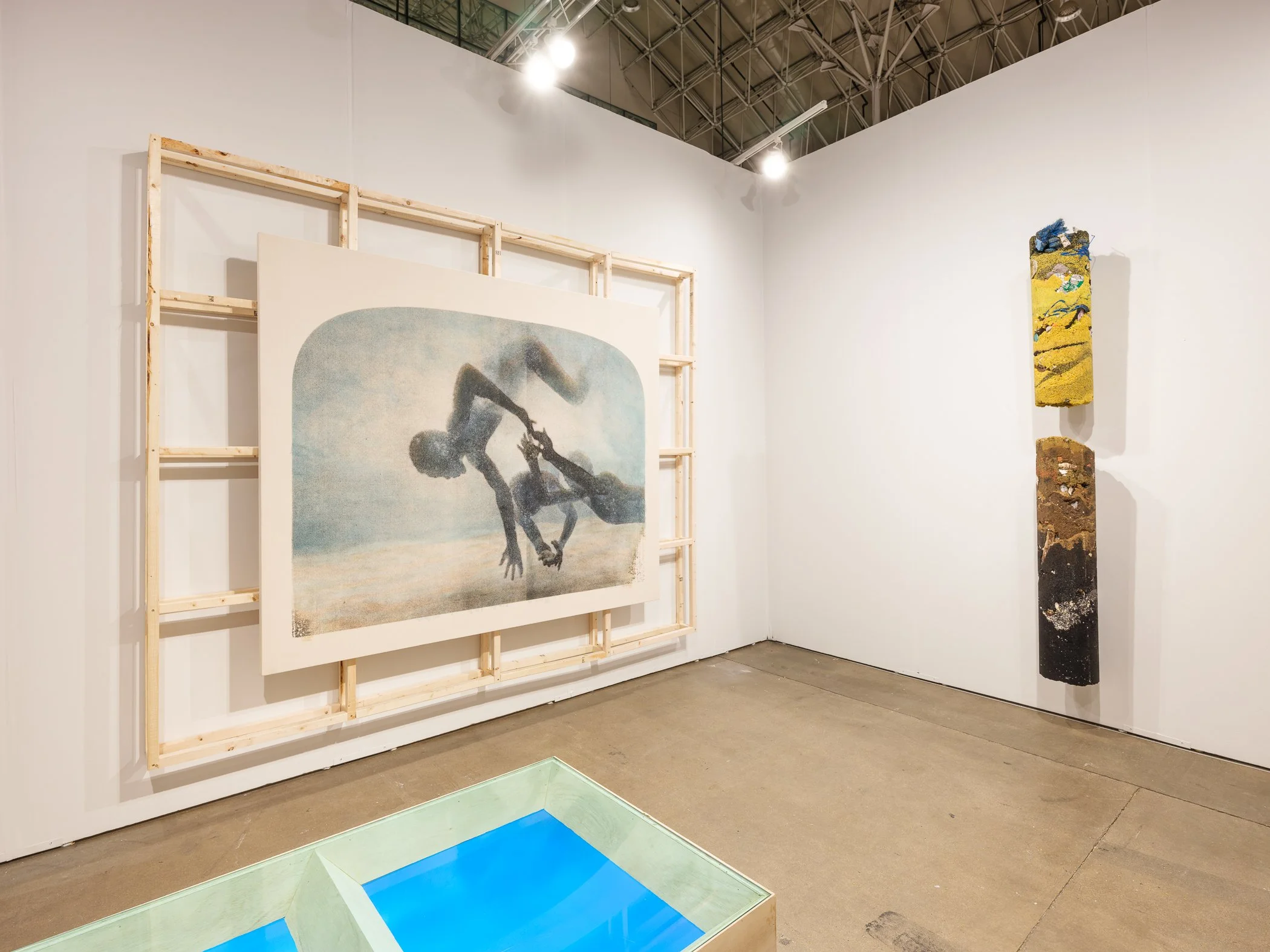EXPO Chicago 2025
Simon Benjamin
April 24th–27th, 2025
Navy Pier’s Hall
Photo Credit Silvia Ros
They cultivated an intimacy with the sea, testing its limits and their own. The water became an extension of the world they could negotiate in a Caribbean still heavy with the residues of slavery, contemplating if emancipation was theoretical or emerging through tangible actions. How much air could they keep in their lungs as they submerged into the depths of the sea? Delving into the histories of coin divers as the focal point in an interwoven dialogue across silkscreen prints on canvas, video and found object sculpture, Simon Benjamin engages in a sustained meditation with the colonial tensions embedded in the construction of the region. Alongside the realities of a region that is a persistent site of both tourism and natural resource exploitation, he considers the potential of the sea as another space to experience the contours of the body, and imagine expansively beyond the coastline. This lies within ongoing intertwined classist and racial legacies of Jamaica where most cannot swim, and public access to the sea remains under the contentious monopoly of hotel privatization of beaches.
Photo Credit Silvia Ros
Amidst the call to critically engage archival records in attempts to piece together buried histories, interrogate notions of truth, and affirm voices that have been suppressed, can one also hold the difficult, violent conditions that have shaped the colonial archives of Black people cultivating their lives in the Americas? Gymnopédies No.1 magnifies the divers’ presence, enlarging stills from the first underwater film shot in the Bahamas in 1914. Positioned as prototypes for cinematic developments, filmmaker J.E. Williamson recorded young coin divers on celluloid as test footage ahead of shooting Terrors of the Deep (1914). The Caribbean has long been the experimentation ground for racial capitalism and technological innovation.
At this large scale, 72x84 inches, the viewer contends with the young men not as small figures solely relegated to a colonial past, but in an ongoing reckoning with colonial realities that persist. Do the historical resonances of the archival image remain, and implicate the viewer when it has been aestheticized through artistic interpretation? There is a yearning to complicate and carve other narratives in the discourse that surrounds colonial era images of Black people, approaches often rooted in care and the possibility of repair. And also one must grapple with the scars, the hieroglyphics of the flesh that Hortense Spillers articulates. Repair will always have limits and the violence that formed such archives does not dissipate. Carry this with thoughtful regard.
The young divers used their knowledge of the harbors to forge limited autonomy and evade the surveillance of police, writes historian Stanley Fonseca. Evasion also comes with an emotional and physical toll. For some tourism operators, the young men exuded the “exotic authenticity” for which the tourists flocked to the Caribbean to capture momentarily. Dressed in small shorts, the divers waited as the tourist ships edged towards shore, their intrusive foreign eyes stirring the entanglements of interracial desire.
Photo Credit Shark Senesac
Memories flow in the currents, sedimented over millennia on the sea floor in a circulation of lives lived, lost and relinquished. How can one ever claim to seek clarity in these waters? Scanning the sea through the plexiglass of a two-channel video installation, Glass Bottom No. 1, there is an anticipation for what may be glanced or “discovered”. Benjamin alludes to commercial forces that survey underwater terrains in search of oil , minerals, and other forms of ecological extraction. Will this destructive drive that tears at the environmental fabric be repaid? The sea will respond.
The records of human damage and worlds undone are compounded into layers of the earth’s subsurface. Benjamin has engaged the practice of creating fabulated core samples, which reference those used to gain geologic data. A cylindrical sculpture with a mixture of beach detritus, sand, cornmeal and resin collected under the Brooklyn Bridge, The Big Oyster, Lenapehoking, NY remembers the indigenous genocide embedded in the American colonial project. The land keeps score of the imperial conquests, from the Caribbean to the U.S. A black layer begins and ends the core sample, gesturing to the richness of the earth that will restore itself regardless.
This body of work, and Simon Benjamin’s broader practice, attends to the foundational textured histories of the Caribbean, recognizing the multiplicity, contradictions and difficult realities. He both affirms Stuart Hall’s incisive understanding that colonialism continues in different iterations while remaining curious to the myriad modes of meaning making and living that unfold.
Essay written by Dr. Gervais Marsh
Installation view. Ph. Cary Whittier






